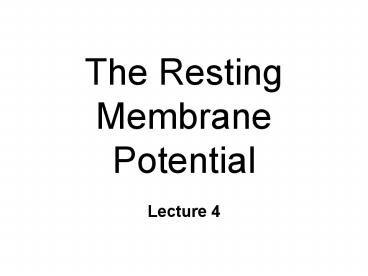The Resting Membrane Potential - PowerPoint PPT Presentation
1 / 30
Title:
The Resting Membrane Potential
Description:
Move from area of high concentration to areas of low concentration ... Z = valence (charge) of ion ~ Equilibrium Potential. Constants never change. Assume 25 oC ... – PowerPoint PPT presentation
Number of Views:258
Avg rating:3.0/5.0
Title: The Resting Membrane Potential
1
The Resting Membrane Potential
- Lecture 4
2
Biolelectric Potential
- Communication within neuron
- electrical signal
- electric current movement of electrons
- Bioelectric movement of ions
3
Ion Distribution
- Particles / molecules
- electrically charged
- Anions
- negatively charged
- Cations
- positively charged
4
Ion Distribution
- Anions (-)
- Large intracellular proteins
- Chloride ions Cl-
- Cations ()
- Sodium Na
- Potassium K
5
Resting Membrane Potential
- Na Cl-
- A- K
outside
Membrane
inside
6
Membrane is polarized
- more negative particles in than out
- Bioelectric Potential
- like a battery
- Potential for ion movement
- current
7
Resting Membrane Potential
outside
Membrane
-
-
-
-
-
-
-
-
-
-
-
inside
8
Bioelectric Potential
OUTSIDE
INSIDE
9
Forces That Move Ions
10
Gradients
- Concentration (C)
- Electrostatic (E)
11
Concentration gradient
- Movement of particles in fluid
- Move from area of high concentration to areas of
low concentration - Diffusion
- Random movement of particles
12
Concentration gradient
Lo
HI
13
Concentration gradient
Lo
HI
14
Electrostatic gradient
- Ions charged particles
- Like charges repel
- Opposite charges attract
15
Electrostatic gradient
like charges repel
16
Electrostatic gradient
opposite
charges attract
17
Equilibrium Potential
- Also called reversal potential
- Distribution of single ion across membrane
- e.g., EK, ENa, ECl-
- Potential for movement of ion if channel opens
- units millivolts (mV)
- outside 0, by convention
18
Equilibrium Potential
- R gas constant
- F Faraday constant
- T temperature (K)
- Z valence (charge) of ion
19
Equilibrium Potential
- Constants never change
- Assume 25 oC
- Use log10
20
Equilibrium Potential
21
Membrane Potential
- Net bioelectric potential
- for all ions
- Balance of both gradients
- concentration electrostatic
- Units millivolts (mV)
- Vm -65 Mv
- given by Goldman equation
22
Membrane Potential Goldman Equation
- P permeability
- Net potential movement for all ions
- known VmCan predict direction of movement of any
ion
23
Organic anions - Membrane impermeable Opposing
electrical force not required
Vm -65 mV
A-
24
Chloride ion
Cl-
Vm -65 mV
- Concentration gradient equal to electrostatic
gradient. - Leaks out neuron
- ECl- - 65 mV
25
Potassium ion
Vm -65 mV
K
- Concentration gradient greater than electrostatic
gradient. - Leaks out neuron
- EK - 75 mV
26
Na
Sodium ion
C
Vm -65 mV
- Concentration gradient and electrostatic gradient
into neuron. - ENa 55 mV
27
Metabolic Pumps
- Active Transport mechanisms
- Require energy
- Move materials against gradient
- Na - K
- Calcium - Ca
- Nutrients, etc.
28
Na - K Pump
- Maintains gradients at rest
- Pumps 3 Na out of cell
- 2 K into cell
- Energy ATP
29
Inside
Outside
Na
Na
Na
K
K
30
Inside
Outside
K
K
K
K































